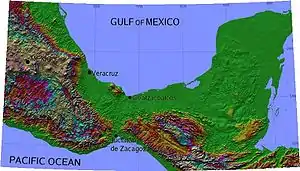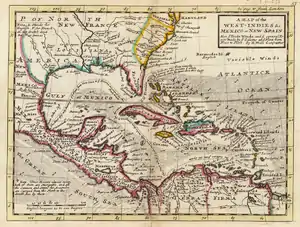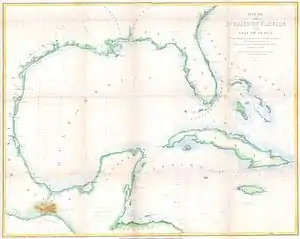Isthmus of Tehuantepec
The Isthmus of Tehuantepec (Spanish pronunciation: [tewanteˈpek]) is an isthmus in Mexico. It represents the shortest distance between the Gulf of Mexico and the Pacific Ocean. Prior to the opening of the Panama Canal, it was a major overland shipping route known simply as the Tehuantepec Route. The name is taken from the town of Santo Domingo Tehuantepec in the state of Oaxaca; this was derived from the Nahuatl term Tēcuāntepēc ("jaguar mountain").



Geography
The isthmus includes the part of Mexico lying between the 94th and 96th meridians west longitude, or the southeastern parts of Veracruz and Oaxaca, including small areas of Chiapas and Tabasco. The states of Tabasco and Chiapas are east of the isthmus, with Veracruz and Oaxaca on the west.[1]
At its narrowest point, the isthmus is 200 km (124 mi) across from gulf to gulf,[2] or 192 km (119 mi) to the head of Laguna Superior on the Pacific coast. The Sierra Madre breaks down at this point into a broad, plateau-like ridge, whose elevation, at the highest point reached by the Ferrocarril Transistmico railway at Chivela Pass, is 224 m (735 ft). The northern side of the isthmus is swampy and densely covered with jungle, which has been a greater obstacle to railway construction than the grades in crossing the sierra.[1]
The Selva Zoque in the eastern-central region of the isthmus is an area of great ecological importance, the largest remaining area of tropical rainforest in Mexico and holding the majority of the terrestrial biodiversity in Mexico.[3]
The Sierra Madre de Oaxaca mountains flatten to form Chivela Pass before the Sierra Madre de Chiapas mountains resume to the south, so geographically the isthmus divides North America from Central America. The southern edge of the North American tectonic plate lies across the Motagua Fault in Guatemala, so geologically, the division between North America and Central America (on the Caribbean Plate) is much farther south than the isthmus of Tehuantepec.
Biogeography
The Isthmus of Tehuantepec, a valley otherwise surrounded by montane habitats, has also been noted as an important biogeographical barrier among montane taxa, such as Mexican birds.[4][5] Population diversification has been observed among, not only avian fauna, but other organisms as well, including toads[6] and the Central American River Turtle.[7] As a result, the Isthmus presents a case of allopatric speciation wherein a geographic divide gives rise to population divergence and a significant decrease in gene flow.
Climate
The predominant climates in the region are tropical savanna (primarily in the south) and tropical monsoon (primarily in the north). There are also small central areas with a temperate climate due to elevation. The annual rainfall on the Atlantic or northern slope is 3,960 mm (156 in) and the maximum temperature about 35 °C (95 °F) in the shade. The Pacific slope has a light rainfall and dryer climate.[1]
| External image | |
|---|---|
The narrowness of the isthmus, and the gap in the Sierra Madre, allow the trade winds from the Gulf of Mexico to blow through to the Pacific. Normally, these winds are not particularly strong, but periodically, a surge of denser air originating from the North American continent will send strong winds through the Chivela Pass and out over the Gulf of Tehuantepec on the Pacific coast. This wind is known as the Tehuano. The region has one of the best wind resources in Mexico, with several wind farms.[8][9]
People and culture
In the Oaxaca half of Tehuantepec, the population is composed mostly of indigenous Zapotec peoples. The women are the traders in the Oaxacan Tehuantepec area and do little menial work. Known as "Tehuanas", these women are known throughout Mexico for their colorful dresses, assertive personalities, and relatively equal relations with men, leading some to characterize them as "matriarchal".
Cuisine
The cuisine of the region is based upon traditional foods and ingredients. Dishes may range from simple to elaborate; most dishes incorporate maize and moles. Common items include tamales made with iguana, chicken, beef or armadillo; guetabingui (fried balls of rice and shrimp); Garnachas topped with dried queso Oaxaca; and pozol, a maize-based drink.[10][11]
Tehuantepec route
.png.webp)
Since the days of Hernán Cortés, the Tehuantepec isthmus has been considered a favorable route, first for an interoceanic canal, and since the 19th century for an interoceanic railway.[12] Its proximity to the axis of international trade gives it some advantage over the Panama route.[1] The Isthmus of Panama, however, is significantly narrower, making for a shorter traversal, even if the canal is farther from trade routes.
The 1854 Gadsden Purchase treaty[13] included a provision allowing the U.S. to transport mail and trade goods across the Isthmus of Tehuantepec via a plank road and railroad.[14] The 1859 McLane-Ocampo Treaty, which Benito Juárez signed but was never ratified by the United States Congress,[15] would have given the U.S. extensive transit rights along the same route.
When the great cost of a canal across the isthmus compelled engineers and capitalists, James B. Eads proposed to construct a quadruple track ship-railway, and the scheme received serious attention for some time.[16] Then came projects for an ordinary railway, and several concessions were granted by the Mexican government for this purpose from 1857 to 1882. In the latter year the Mexican government resolved to undertake the railroad construction on its own account, and entered into contracts with a prominent Mexican contractor for the work. In 1888 this contract was rescinded, after 108 km (67 mi) of road had been completed.[1][17]
The next contract was fruitless because of the death of the contractor, and the third failed to complete the work within the sum specified (GB£2,700,000).[1] This was in 1893, and 60 km (37 mi) remained to be built. A fourth contract resulted in the completion of the 130-mile line from coast to coast in 1894.[18] But, it was found that the terminal ports were deficient in facilities[19] and the railroad was too light for heavy traffic.[1][19][20]
The government then entered into a contract with the London firm of contractors of S. Pearson & Son, Ltd., who had constructed the drainage works of the valley of Mexico and the new port works of Veracruz, to rebuild the line and construct terminal ports at Coatzacoalcos on the Gulf coast, and at Salina Cruz on the Pacific side. The work was done for account of the Mexican government. Work began on 10 December 1899, and was finished to a point where its formal opening for traffic was possible in January 1907.[1][20]
Tehuantepec Railway Line
The Tehuantepec railway (now the Ferrocarril Transístmico ("Trans-Isthmic Railroad")), is 308 km (191 mi) long, running from the port of Coatzacoalcos on the Gulf of Mexico to Salina Cruz in Oaxaca on the Pacific coast, with a branch of 29 km (18 mi) between Juile and San Juan Evangelista. The minimum depth at low water in both ports is 10 m (33 ft). An extensive system of quays and railway tracks at both terminals affords ample facilities for the expeditious handling of heavy cargoes. The general offices and repair shops of the original Tehuantepec Railway were located at Rincón Antonio, at the entrance to the Chivela Pass.[1] At Santa Lucrecia, 175 km (109 mi) from Salina Cruz, connection was made with the Veracruz & Pacific Railway, 343 km (213 mi) to Córdoba, Veracruz, and 500 km (310 mi) to Mexico City. Those connecting lines are now owned and operated by Ferrosur, a company that also operates along the Ferroistmo-owned Tuehantepec line.
Several proposals have been made for modernizing the inter-ocean rail connection.[15]
See also
References
-
 One or more of the preceding sentences incorporates text from a publication now in the public domain: Chisholm, Hugh, ed. (1911). "Tehuantepec". Encyclopædia Britannica. 26 (11th ed.). Cambridge University Press. p. 507.
One or more of the preceding sentences incorporates text from a publication now in the public domain: Chisholm, Hugh, ed. (1911). "Tehuantepec". Encyclopædia Britannica. 26 (11th ed.). Cambridge University Press. p. 507. - Hovey, Edmond Otis (1907). "The Isthmus of Tehuantepec and the Thehuantepec National Railway". Bulletin of the American Geological Society. 39 (1): 78–91.
- "Selva Zoque". EEF Mexico. Archived from the original on 2010-05-27. Retrieved 2010-06-28.
- Barber, B. R.; Klicka, J. (2010-09-07). "Two pulses of diversification across the Isthmus of Tehuantepec in a montane Mexican bird fauna". Proceedings of the Royal Society B: Biological Sciences. 277 (1694): 2675–2681. doi:10.1098/rspb.2010.0343. ISSN 0962-8452. PMC 2982039. PMID 20410037.
- Sandoval, Luis; Epperly, Kevin L.; Klicka, John; Mennill, Daniel J. (2017-03-07). "The biogeographic and evolutionary history of an endemic clade of Middle American sparrows: Melozone and Aimophila (Aves: Passerellidae)". Molecular Phylogenetics and Evolution. 110: 50–59. doi:10.1016/j.ympev.2017.03.008. ISSN 1095-9513. PMID 28286101.
- Mulcahy, Daniel G.; Morrill, Benson H.; Mendelson, Joseph R. (2006). "Historical biogeography of lowland species of toads (Bufo) across the Trans-Mexican Neovolcanic Belt and the Isthmus of Tehuantepec". Journal of Biogeography. 33 (11): 1889–1904. doi:10.1111/j.1365-2699.2006.01546.x. ISSN 1365-2699.
- González-Porter, Gracia P.; Maldonado, Jesús E.; Flores-Villela, Oscar; Vogt, Richard C.; Janke, Axel; Fleischer, Robert C.; Hailer, Frank (2013-09-25). "Cryptic Population Structuring and the Role of the Isthmus of Tehuantepec as a Gene Flow Barrier in the Critically Endangered Central American River Turtle". PLOS ONE. 8 (9): e71668. Bibcode:2013PLoSO...871668G. doi:10.1371/journal.pone.0071668. ISSN 1932-6203. PMC 3783458. PMID 24086253.
- Toledo, César; Chávez-Arroyo, Roberto; Loera, Leonel; Probst, Oliver (18 May 2015). "A surface wind speed map for Mexico based on NARR and observational data". Meteorological Applications. 22 (3): 3.4. Bibcode:2015MeApp..22..666T. doi:10.1002/met.1500.
the highest wind speeds are observed in the Southern region of Oaxaca at the Isthmus of Tehuantepec bridging the Pacific Ocean and the Gulf of Mexico. This region has long been known to be Mexico's windiest region and has been the object of a strong wind power development
- Duncan Wood, Samantha Lozano, Omar Romero & Sergio Romero. "Wind energy on the border — a model for maximum benefit" Woodrow Wilson International Center for Scholars, May 2012. Quote: "wind energy projects that have been developed in the southern state of Oaxaca. There, the wind currents that cross the Isthmus of Tehuantepec"
- "Garnachas Istmeña". Autorneto. Retrieved 2011-06-26.
- "What to Eat in the Isthmus of Tehuantepec". Secretary of Tourism and Economic Development of the State of Oaxaca. Retrieved 2011-06-26.
- Powell, Fred Wilbur (1921). The Railroads of Mexico. Boston, Mass.: The Stratford Co. p. 149.
- "Gadsden Purchase Treaty : December 30, 1853" Archived August 19, 2006, at the Wayback Machine, The Avalon Project
- See "Tehuantepec Railroad--Sloo's Grant"; The New York Times, May 5, 1853, p. 4.
- Howard LaFranchi, "Mexico Wants Its Own 'Panama Canal' - Without US", The Christian Science Monitor. Sept. 4, 1996. Retrieved 2018-01-25.
- John H. Lienhard, "An Un-Panama Canal", Engines of Our Ingenuity No. 1777, citing J. E. Vollmar, Jr., "The Most Gigantic Railroad". Invention and Technology, Vol. 18, No. 4, Spring 2003, pg. 64.
- U.K. Foreign Office, Mexico; Report on the Mexican Isthmus (Tehuantepec) Railway No. 658, Miscellaneous Series, Diplomatic and Consular Reports; April, 1907.
- "The Tehuantepec Railroad; An Important Mexican Enterprise Completed"; The New York Times, November 22, 1894, p. 12.
- Edward B. Glick, "The Tehuantepec Railroad: Mexico's White Elephant", Pacific Historical Review, Vol. 22, No. 4 (1953), pp. 373-382; published by: University of California Press. Retrieved 2018-01-25.
- Report on the Mexican Isthmus (Tehuantepec) Railway, p. 5.
External links
| Wikimedia Commons has media related to Isthmus of Tehuantepec. |
- The Tehuantepec Ship-Railway
- The Mexican Railways, with information on the current owners (concessions) of Mexican railways.
- Beach, Chandler B., ed. (1914). . . Chicago: F. E. Compton and Co.
